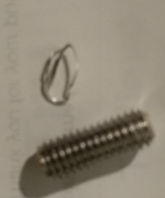I bet they used an oversize drill to make tapping easier. My cells were very well tapped, and an excellent fit for the M6 studs.
So I spent a lot more time inspecting my threads including the one stripped thread and I just may luck out.
First, when I compare an M4 bolt that I purchased compared to the bundled all-in-one (permanently preattached washer and lock washer below nut head and above threads) SS M6 bolts that came with my batteries, I get play of 1mm wiggling lightly-threaded bundled SS bolts while the newly-purchased bolt has less play (~0.5mm), so the bundled SS M4 bolts may be undersized, exacerbating the problem.
I get 4-3/4 turns from first thread grab to light contact with the bottom and I can see what looks like 5 threads down the side of each hole.
The upper 3 threads of all of the terminals I torqued to 4Nm / 35inch-lbs yesterday are noticeably worn compared to the lowest 2 threads and compared the the upper 3 threads of the cells which have never been torqued (though the upper 3 threads of those bevel-torqued terminals do show some wear versus the lowest 2 threads).
So first, every time you thread and unthread stainless bolts from these soft aluminum terminals, you are weaa as rung down the aluminum threads.
Second, bundled hardware may be undersized which will increase wear and the liklihood of stripping threads.
And third, bundled hardware will often only use the top few threads, leaving the lowest threads pristine.
So the main lesson learned for me is if I purchase any more cells, the first thing I will do is inspect threads and then loctite in an M6 grub screw.
And the other point as far as my stripped thread is that the lowest 2 threads are still intact and pristine and even better, my new M4 bolt grabs a full 4-1/2 threads, so I’m hoping I can loctite in an M6 grub screw and it will hold.
That stripped terminal has a visible aluminum lip that now extends up past the terminal surface so it will need to be cleaned up, but seeing the 2 pristine threads at the bottom makes me hopeful the thread can be salvaged without retapping.
A quick question for those of you that have attached M6 grub screws - is there a reason to back off 1/4 turn after touching the bottom? Is it to provide some safety margin in case the grub screw gets turned further when tightening down a nut?
This one thread has so little fully-intact thread left that I’m considering going all the way to the bottom to maximize holding force of the threads I have left (and seeing to the wear on the upper 3 threads in all of my terminals is making me consider bottoming-out all of my grub screws).
Not going to claim victory yet but I’m a lot more optimistic than I was yesterday...



